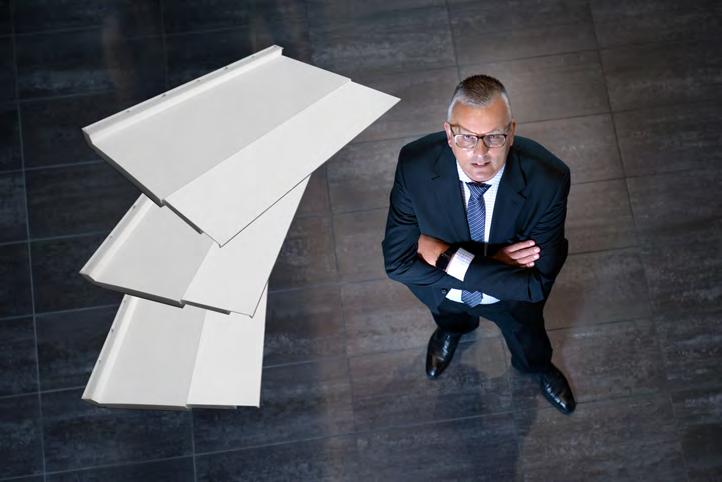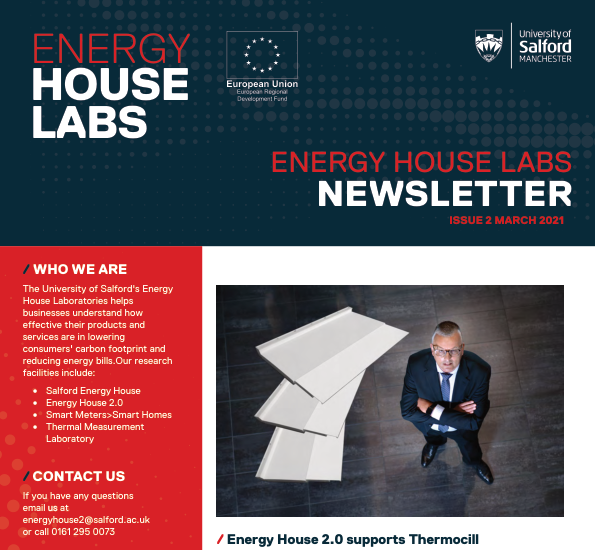Energy House 2.0 supports Thermocill

Keith Rimmer was one of the first people to approach the Energy House 2.0 team with a prototype of his Thermocill device. This is a low-cost passive technology that modifies the flow of convected warm air from a radiator sited under a windowsill (a common location in many homes).
Taking advantage of the free testing under the ERDF funded Energy House 2.0 project Thermocill was tested in January 2020 in the Salford Energy House. The results were very promising and showed that the Thermocill when installed in the ‘Thermal Comfort Suite’ within the Energy House reduced heat loss through the double glazed window, giving energy savings of up to 16% and also resulted in a faster warm up rate. In order to more fully understand the heat transfer mechanisms at play, Keith also commissioned computer aided modelling and further optimised his design.
Things have moved quickly in the past 12 months; Keith has patented his design, formed Thermocill Ltd., and has an agreement in place with MGS Technical Plastics Ltd in Burnley to manufacture Thermocill devices from 100% recycled nylon. Keith is looking forward to some significant sales in 2021 and is committed to social responsibility with a portion of the profits donated into a trust fund to support the provision of modular housing for the homeless.
More information can be found here.

Domestic Retrofit workshop
Are you a construction professional interested in #DomesticRetrofit? Join us for a series of webinars next month. Full details and registration available here.
Thermal Measurement Laboratory
The Thermal Measurement Laboratory [UKAS accredited lab No. 1660], run by Dr Tony Simpson and Ian Rattigan, has been designated (as of 31 December 2020) an Approved Body under the Construction Products Regulation (retained EU law EUR 305/2011) by the Secretary of State of the Ministry of Housing, Communities and Local Government.
The laboratory is recognised by the UK government as competent to carry out Technical Assessment of the performance of thermal insulation products governed by standards EN 13162 to EN 13171, for the UK and Northern Ireland market.
Following a surveillance visit in December 2020 UKAS continued accreditation to management system requirements of BS EN ISO/IEC 17025:2017, covering test standards EN 12664, EN 12667 and ISO 8301, was also successfully completed. The assessors acknowledged that the laboratory has a robust quality system enabling it to continue offering a quality service to customers during what has been a difficult year due to COVID-19.

Smart Homes Ecosystem workshop
The Energy House 2.0 team delivered a series of successful online workshops in March on the Smart Homes Ecosystem.
Led by Dr Ioannis Paraskevas, Head of the Smart Meters > Smart Homes Laboratory, this four-session series had 16 Greater Manchester SMEs sign up and a further 48 businesses from across the UK and internationally register to listen in.
The sessions covered everything from smart meter data, Internet of Things (IoT) devices in the home, and cyber security of these devices. Leading industry experts such as Joshua Cooper from Hildebrand and Chris Barlow from DCC, as well as local businesses, Evergreen and Wondrwall, delivered informative workshop slots.
Recordings of the workshops are available on the Energy House 2.0 website.

Artist in Residence at the Energy House
In December 2020 McCoy Wynne was announced as the Artist in Residence at Energy House – organised in collaboration with the University of Salford Art Collection and industry partners Open Eye Gallery.
McCoy Wynne is a partnership of photographers Stephen McCoy and Stephanie Wynne. Much of their work considers aspects of representation of the built environment and they have a lifelong interest in issues around sustainability.
Stephanie Wynne reflects on the first stage of their residency:
‘We found entering the space a quite surreal experience, passing through many doorways to then enter into another complete building, much like walking into a Russian Doll. The interior of the Energy House had the been stripped of its furnishings and looked like a building awaiting new owners, with left behind glimpses of its previous occupants. Wires and sensors trail across the floors and dangle from ceilings like invading plant life we have so often seen in abandoned buildings.
The house is monitored, measured and observed. Whilst inside, one is aware of being part of that monitoring, of being watched, moving from room to room, raising the temperature and exhaling CO2. In contrast there is a non-view looking out, just the walls of the encasing building. The link to the outside world and the relevance of the experiment is through its researchers and scientists.
We are developing the work via these themes, through continued visits and discourse with the Energy House team. Watch this space!’
Image credits: Initial research images ©McCoy Wynne



Energy House 2.0 Construction Update
The steel frame of the central core and chambers are nearing completion, and the chamber floors are starting to take shape with gas membrane nearly complete and ready for topping with concrete.
For live updates on the build, click here.



